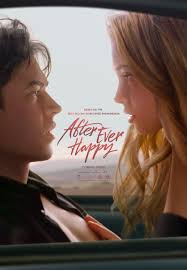Some love stories never really end—they just keep evolving with each new chapter. After Ever Happy (2022), the fourth film in the After series, directed by Castille Landon, brings Josephine Langford and Hero Fiennes Tiffin back as Tessa and Hardin, once again navigating their complex and tumultuous relationship. The film is set in modern-day America, with key scenes taking place in Seattle and London, offering both a sense of domestic intimacy and international drama. As a romance-drama, After Ever Happy leans heavily on emotional intensity and unresolved conflicts, fitting into the franchise’s signature formula of toxic love mixed with the hope of redemption.
The plot picks up where After We Fell left off. Tessa and Hardin are once again at a crossroads in their relationship, with family secrets and personal traumas threatening to tear them apart. This time, the focus shifts more onto Hardin’s emotional journey as he grapples with revelations about his past, which, in turn, affect his ability to be in a healthy relationship. Tessa, meanwhile, is trying to move forward in her life, seeking independence and stability away from the constant push and pull of her love for Hardin. Their on-again, off-again relationship hits new lows as they are forced to confront whether they are truly meant to be together, or if their connection is too destructive to survive. As both characters wrestle with their inner demons, the film builds up to a climactic moment of choice and transformation, though it stops short of offering a clear resolution.
One aspect that stands out in After Ever Happy is the acting, especially from Josephine. Her portrayal of Tessa has evolved significantly since the first film, and here, she brings a maturity and depth to the character that wasn’t as evident before. Tessa’s emotional struggles are portrayed with subtlety and grace, making her inner conflict feel genuine rather than overly dramatic. Josephine’s ability to balance Tessa’s vulnerability with her newfound strength gives the character a relatable arc, even if the script doesn’t always support it. Hero, on the other hand, continues to deliver a brooding performance as Hardin, embodying the character’s deep-rooted pain and anger. While Hardin’s journey feels repetitive at times, Hero manages to bring enough intensity to his role to keep the audience engaged. The chemistry between the two leads remains the film’s strongest asset, driving the emotional core of the story even when the plot falters.
The direction by Castille Landon shows some improvement over previous installments. Landon’s ability to balance the intimate emotional moments with the larger dramatic set pieces helps the film flow more smoothly than its predecessors. The film relies heavily on close-up shots, often focusing on the characters’ faces during pivotal moments of conflict or affection, which helps to emphasize the emotional stakes. However, some scenes still feel drawn out or repetitive, particularly when the story circles back to the same relationship issues without significant progress. The pacing of the film can feel slow at times, especially in the middle portion, where the narrative meanders before picking up speed again toward the end.
Cinematography plays a crucial role in setting the tone for After Ever Happy. The visual style, marked by muted color palettes and soft lighting, creates an atmosphere of melancholy that mirrors the emotional turmoil of the characters. The use of light and shadow is particularly effective during scenes where Tessa and Hardin are at odds, with darker tones emphasizing their internal struggles. There are also moments where the camera work subtly highlights the physical distance between the characters, reinforcing the emotional barriers they must overcome. While the cinematography is not groundbreaking, it serves its purpose in supporting the film’s overall mood.
The music and soundtrack once again play a key role in building the emotional intensity of the film. Contemporary tracks by artists like Tate McRae and Lea Rue underscore the romantic and dramatic moments, often enhancing the mood of a scene. The choice of music feels carefully curated to resonate with the film’s younger audience, blending indie-pop and moody ballads that reflect Tessa and Hardin’s inner emotions. However, at times, the music feels too on-the-nose, almost dictating how the audience should feel rather than allowing the emotions to develop naturally through the performances.
Another notable element is the theme of personal growth and healing, which is more prevalent in this film compared to earlier installments. Tessa’s journey toward self-realization and independence is a central focus, and while the film doesn’t always do her arc justice, it is refreshing to see her character grow beyond her relationship with Hardin. The film attempts to explore themes of forgiveness, trauma, and self-worth, though the execution often falls into melodrama. Hardin’s struggles with his family’s dark secrets, while intriguing, don’t quite offer the character development one might hope for, as he remains stuck in the same destructive patterns for much of the film.
One area where the film could have improved is in the dialogue and screenplay. The script often leans too heavily on dramatic monologues and heated arguments, which can feel overwrought after a while. There are moments where the dialogue feels repetitive, with characters rehashing the same issues without making any meaningful progress. While this may reflect the cyclical nature of Tessa and Hardin’s relationship, it can also be frustrating for viewers who are looking for more substantial character growth. Additionally, some of the secondary characters, like Landon and Kimberly, feel underutilized, serving more as plot devices than fully fleshed-out individuals.
Despite its flaws, After Ever Happy succeeds in delivering what fans of the series expect: a dramatic, emotionally charged love story with high stakes and passionate performances. For those who have followed Tessa and Hardin’s journey from the beginning, this film offers a satisfying continuation, even if it doesn’t provide all the answers. The film’s focus on healing and personal growth gives it a slightly more mature tone than previous installments, though it still falls into some of the same traps of melodrama and repetition.
In conclusion, After Ever Happy is a mixed bag of intense emotions, solid performances, and a story that continues to walk the line between toxic romance and personal redemption. It’s a film that will undoubtedly resonate with fans of the series, but may leave newcomers or casual viewers feeling a bit underwhelmed by its lack of narrative depth and repetitive conflicts. For those invested in Tessa and Hardin’s tumultuous relationship, this installment offers enough emotional weight and unresolved tension to keep the saga alive. However, viewers looking for a more nuanced exploration of love and personal growth may find themselves yearning for something deeper. If you’re a fan of dramatic love stories filled with angst and passion, After Ever Happy will likely hit the right notes, but don’t expect it to stray too far from the formula that has defined the series so far.







